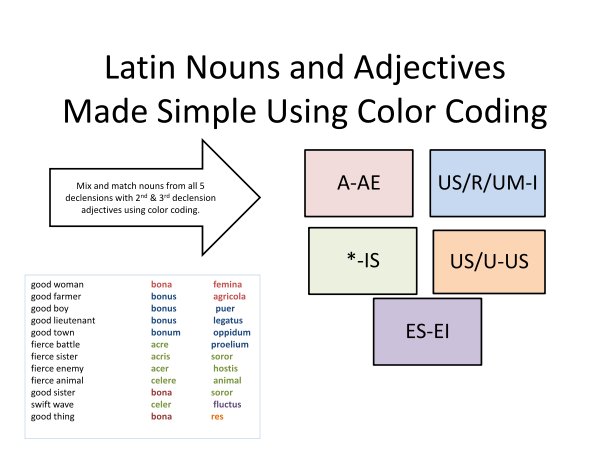Color Coded Latin: A Teaching Method
by Kathleen Canning
© 2011
Download "Color Coded" Latin Teaching Method
- Preface
- Color Chart
- First Declension
- Second Declension
- Third Declension
- Fourth Declension
- Fifth Declension
- First Conjugation
- Second Conjugation
- Third Conjugation
- Fourth Conjugation
- Irregular Verbs
- Latin Sentences Using Declensions and Conjugations
- The Genitive Case
- The Dative Case
- Prepositional Phrases
- Pronouns
- Interrogative Pronouns
- Demonstrative Pronouns
- Subjunctive ARE Verbs
- Subjunctive Long ERE 2nd Conjugation Verbs
- Subjunctive ERE 3rd Conjugation Verbs
- Subjunctive I-Stem 3rd Conjugation Verbs
- Subjunctive IRE 4th Conjugation Verbs
Always listen to the learners
One day my youngest daughter asked me why teachers try to make everything so difficult instead of giving a simple overview, a goal and some suggestions. She promptly pulled out an article explaining DNA and explained it to me the way that her teacher explained it to her. I did not know what she was talking about. Then she drew a zipper and explained DNA her way and it made sense almost instantly. After that, I tried my best to teach using simple but visual methods. Little by little over a period of years, I managed to color code Latin and had students come to class with what I called a Latin pen. The pen was just an ordinary Bic with multiple color ink mechanisms.
The better the teacher understands the subject the easier it is to simplify lessons.

Color coding removes the confusion of making nouns agree with second and third declension adjectives in case, number and gender. The verb structure, was another obstacle. Eureka ! One day a student was sitting in the back of the room drawing on her hands as we reviewed the four conjugations of verbs in the active and passive voice. I asked her what she was doing, and she said that if she used six fingers she could have all the active voice endings for the person, tense and number in view and then it would not be so hard for her. I appreciated her desire to learn even though her memory was giving her problems. She improved steadily and I had a light bulb moment. If this worked for her, why wouldn't it work for all students? From that day we all made verb hands which could also be used as a bookmark.
Then year after year, we refined it until it was a two sided hand with color coding to separate the first three tenses, present imperfect and future from the next three perfect tenses. Now even students without great memories could master the structure of the Latin verbs. If they kept their colored charts and Latin hands in front of them they could complete multiple Latin drills without making senseless errors I hoped that the structure stayed in their heads as they moved on to Latin related modern languages.
Even today, I run into students, who rather than say "hello", say O-Bam-Bo I-Eram- Ero. They may have forgotten why they remembered those verb endings but they have stayed anchored in their minds.
Is it more important to work from memory than it is to use a visual and learn the information simply and correctly?
I continue to believe that a student is better off learning the material using the easiest and most organized methods available. There are many teachers, who still consider it watered down academia when students use a visual as they work. Knowing how to use a calculator to solve a chemistry problem makes more sense to me than having to use just your own brain. I guess if all of the electricity in the world fails some day , it will be a good thing that there are still students who can do all the work in their heads. However, anything that benefits student learning is my idea of a plus in education.
Even the very bright learners benefit from simple instructions. Keeping instruction clear and simple lessens the time needed to comprehend the basics and gives the learner a quicker start to mastery.
Who will benefit from using my color coded charts?
Just to keep the record straight, I benefited from using these student- inspired charts. Once it was all organized in my head, it became easier to fold the material like pairs of clean socks and pack the lessons into the correct brain drawers. If I need a pair of hiking socks, or a third declension adjective, I can just go to the green drawer and pull out the correct match ,like the adjective to match a third declension ,feminine noun. Teachers will find that the method works very well with first year students or reviewing with more advanced classes.
This also helps the students who self teach. The world is full of people who teach themselves all sorts of skills. My grandfather taught himself Law, Latin and French back in the early 1900's and used to hold the distinction of being one of the youngest to pass the Bar. I still remember his law library behind glass. Some learners might be very interested in liturgical music and just want a quick and simple refresher course. English teachers will find a treasure trove of grammar background in elementary Latin lessons. Cases and syntax, clauses, verb tenses and moods are there for harvesting.
The real beauty of color coding Latin is that it is so simple for so many learners. In hoc signo vinces.
Return To Latin Main
Next Page - First Declension
